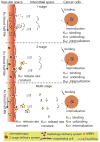Towards Optimal Design of Cancer Nanomedicines: Multi-stage Nanoparticles for the Treatment of Solid Tumors
- PMID: 25670323
- PMCID: PMC4519365
- DOI: 10.1007/s10439-015-1276-9
Towards Optimal Design of Cancer Nanomedicines: Multi-stage Nanoparticles for the Treatment of Solid Tumors
Abstract
Conventional drug delivery systems for solid tumors are composed of a nano-carrier that releases its therapeutic load. These two-stage nanoparticles utilize the enhanced permeability and retention (EPR) effect to enable preferential delivery to tumor tissue. However, the size-dependency of the EPR, the limited penetration of nanoparticles into the tumor as well as the rapid binding of the particles or the released cytotoxic agents to cancer cells and stromal components inhibit the uniform distribution of the drug and the efficacy of the treatment. Here, we employ mathematical modeling to study the effect of particle size, drug release rate and binding affinity on the distribution and efficacy of nanoparticles to derive optimal design rules. Furthermore, we introduce a new multi-stage delivery system. The system consists of a 20-nm primary nanoparticle, which releases 5-nm secondary particles, which in turn release the chemotherapeutic drug. We found that tuning the drug release kinetics and binding affinities leads to improved delivery of the drug. Our results also indicate that multi-stage nanoparticles are superior over two-stage nano-carriers provided they have a faster drug release rate and for high binding affinity drugs. Furthermore, our results suggest that smaller nanoparticles achieve better treatment outcome.
Conflict of interest statement
Figures






References
-
- Baish JW, Gazit Y, Berk DA, Nozue M, Baxter LT, Jain RK. Role of tumor vascular architecture in nutrient and drug delivery: an invasion percolation-based network model. Microvasc Res. 1996;51:327–46. - PubMed
-
- Baxter LT, Jain RK. Transport of fluid and macromolecules in tumors. I. Role of interstitial pressure and convection. Microvasc Res. 1989;37:77–104. - PubMed
-
- Chauhan VP, Stylianopoulos T, Boucher Y, Jain RK. Delivery of molecular and nanomedicine to tumors: Transport barriers and strategies. Annu Rev Chem Biomol Eng. 2011:281–298. - PubMed
Publication types
MeSH terms
Substances
Grants and funding
- T32 CA073479/CA/NCI NIH HHS/United States
- R01 CA126642/CA/NCI NIH HHS/United States
- R01-CA085140/CA/NCI NIH HHS/United States
- R01 CA098706/CA/NCI NIH HHS/United States
- R01 CA085140/CA/NCI NIH HHS/United States
- R01-CA115767/CA/NCI NIH HHS/United States
- P01-CA080124/CA/NCI NIH HHS/United States
- P01 CA080124/CA/NCI NIH HHS/United States
- R01-CA126642/CA/NCI NIH HHS/United States
- R01-CA096915/CA/NCI NIH HHS/United States
- R01 CA115767/CA/NCI NIH HHS/United States
- R01 CA096915/CA/NCI NIH HHS/United States
- T32-CA073479/CA/NCI NIH HHS/United States
LinkOut - more resources
Full Text Sources
Other Literature Sources

